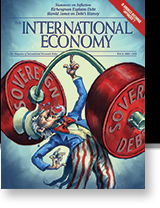Conventional gasoline price since 1990.
Are Low Wage Wages Keeping Up with Inflation
If accommodation and food service wages evolve in October in the same way the have covaried with overall leisure and hospitality service wages, then the answer is yes, for a variety of price indexes.
A “Fiscal Cliff Scenario” – A Symposium of Views in The International Economy
October Inflation – Different Measures
Chained, and particularly Trimmed, and Sticky Price CPI are less than headline.
October CPI Inflation
Headline CPI exceeded expectations substantially, with m/m 0.9% vs. 0.6% expected. Core was 0.6% vs. 0.4% expected (Bloomberg consensus). The persistence in the gap will depend in large part on oil price’s evolution. Year-on-year core matches levels last seen in 1991; but still far below the 1970’s.
Anti-Elitism or Anti-Other-ism?
Econbrowser reader Manfred, in responding to my critique of the late Mr. Limbaugh’s use (or non-use) of statistics, writes of me:
…you had access to schools that many others in the US do not…
Five Measures of Real Average Hourly Earnings in Accommodation & Food Services
Still likely rising. We’re awaiting October CPI numbers, and October wages for accommodation and food services, but using nowcasts and extrapolations, we can show what real wages look like through October.
Economists Stereotypes
Econbrowser reader sammy claims:
1) Economists have limited exposure to the real world
2) Economists extrapolate off last period statistics, which are much more imprecise than they acknowledge
3) Economists are ideological and can torture statistics to reach the desired outcome
Macro Implications of BBB and IIJA Passage
We are still in the process of determining what’s in the Build Back Better (BBB) bill, but it approximates what is currently discussed, it in conjunction with the Infrastructure Investment and Jobs Act (IIJA) will not likely lead to much pressure in credit markets and upward pressure in prices, given it is largely paid for. Here (while we wait for the CBO) are Moody’s Analytics projections (as of 11/4).
Long-lived Negative Consequences of Steel Tariffs
(not in 2018, but in 2002-03):
